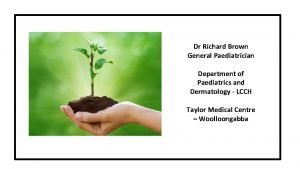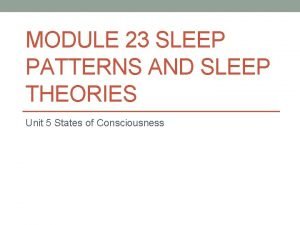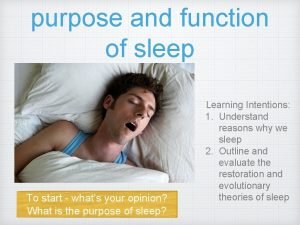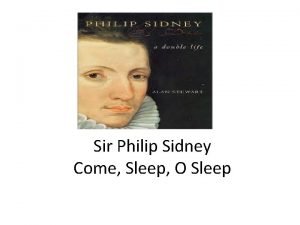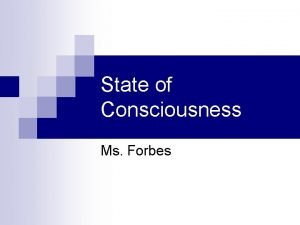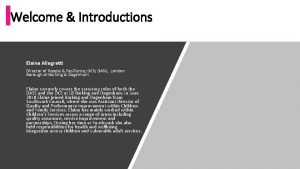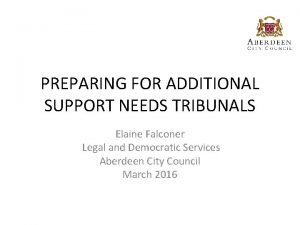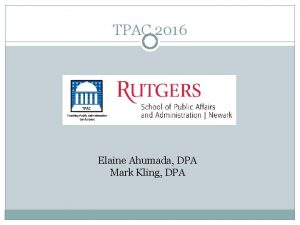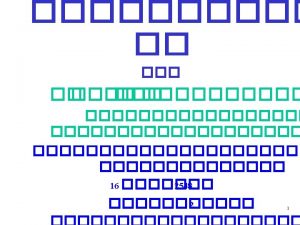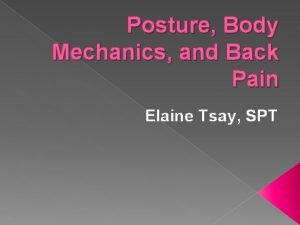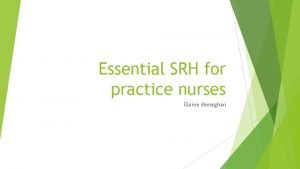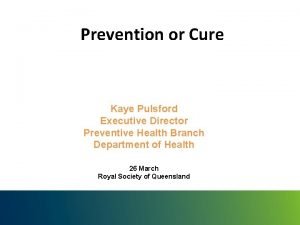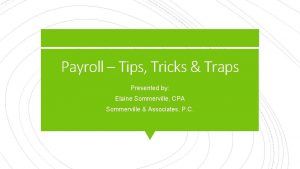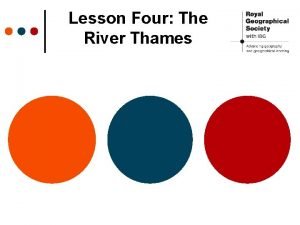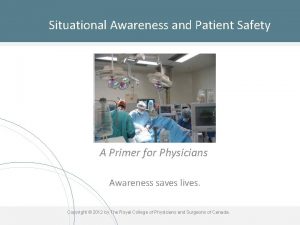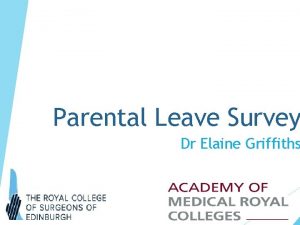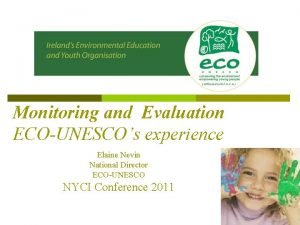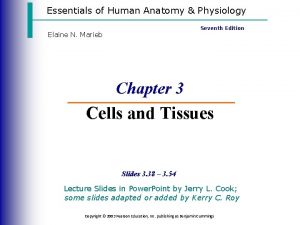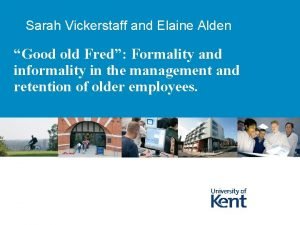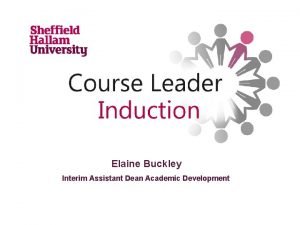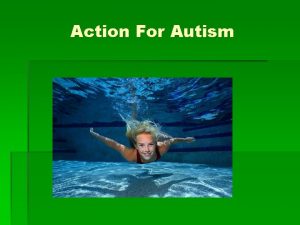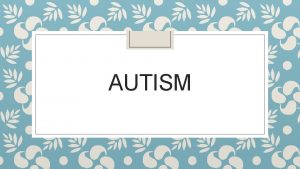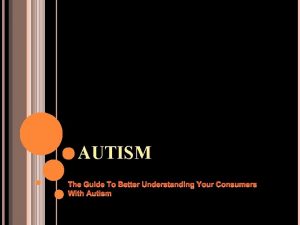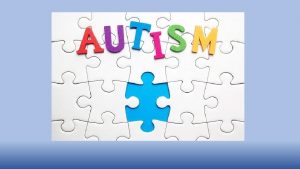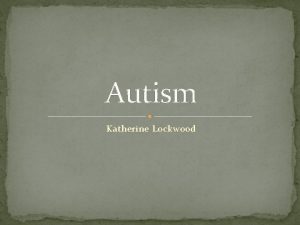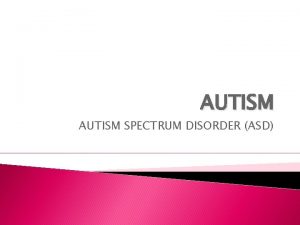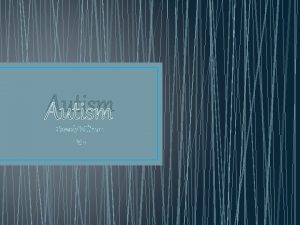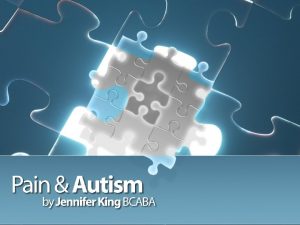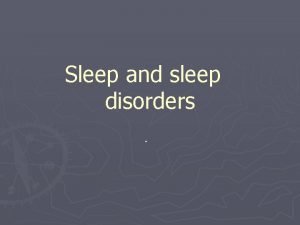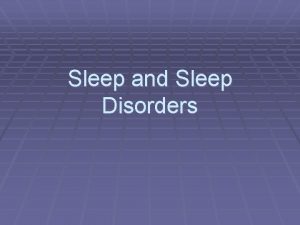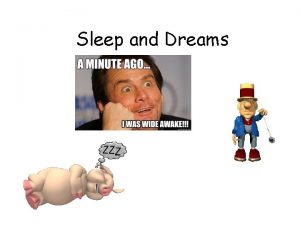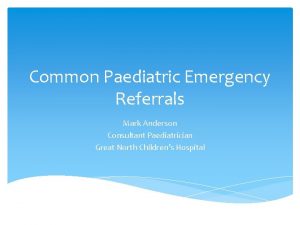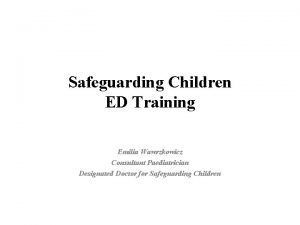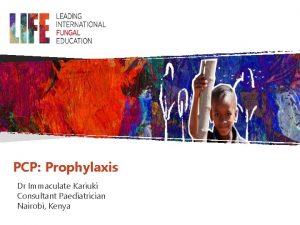Autism and Sleep Dr Elaine Clark Consultant Paediatrician













































- Slides: 45

Autism and Sleep Dr Elaine Clark Consultant Paediatrician

Sleep disorders and Autism Around two-thirds of children with ASD have sleep disorders. (Richdale 2000) Children with ASD can have sleep problems from 18 months onwards Parents of children with autism have more sleep problems that parents of “typically” developing children.

What we will be covering What is normal sleep? What do we mean by sleep problems? Why children have difficulty with sleeping? How we can help them to sleep?

What is normal sleep?


Teenagers? ? Natural not to fall asleep before 11 pm. Hormonal changes programmed to fall asleep around 2 hours later. Need around 9 hours sleep. Consideration of allowing teenagers to start school later.

What we will be covering What is normal sleep? What do we mean by sleep problems? Why children have difficulty with sleeping? How we can help them to sleep?

Sleep Disorders Difficulty falling asleep Difficulty staying asleep Early waking Night terrors Sleeping in parent’s bed

What happens when children are sleep deprived?

Daytime sleepiness?

Sleep monitoring in school age children 2 -4 th Grade Fragmented or less sleep More behaviour problems reported by parents and teachers Older students decreased academic performance

What we will be covering What is normal sleep? What do we mean by sleep problems? Why children have difficulty with sleeping? How we can help them to sleep?

Lack of routine Unpredictability Bed time differs each night Falling asleep in various places

Fear Darkness Being alone The unknown Noise Silence

Anxiety Perseveration of thoughts Things changing while they are asleep. Occurrences during that day/week/year. Things that are about to happen Be aware that your own tone of voice, feelings and body language will affect your child.

Social sense Why we need to sleep? When we need to sleep? Connection between going to bed and going to sleep.

Environment Moving to their own room Changes to room Lighting: fluorescent light reported to hurt eyes Noises: squeaky door, sound of TV, parents going to bed Smells Touch: one lady unable to sleep if one leg was touching the other. Visual: colour, patterns, toys, shadows.

Why children with ASD can’t sleep? "Sleep was not a secure place. Sleep was a place where darkness ate you alive. Sleep was a place without colour or light. In the darkness you could not see your reflection. “ "I was afraid to sleep, always had been. I would sleep with my eyes open and I did this for years” by Donna Williams

Chemical Caffeine and sugar rich foods Melatonin: a hormone produced in the brain in response to reduction in light. Causes drowsiness at dusk in humans. Levels begin to increase 2 to 3 hours before sleep. Spring time melatonin production starts 20 minutes later than Winter Children with ASD produce lower levels of melatonin at night time than “normal” Tordjman 2005 ? Serotonin ? GABA

Teenagers ? Going to bed too early Eating or drinking too late Computers/TV Mobile phones!! The average teen sends 97 texts per day!

Complete Problem List

What we will be covering What is normal sleep? What do we mean by sleep problems? Why children have difficulty with sleeping? How we can help our children to sleep?

Solutions ? ? ? ? Every child is different

Establish a Routine Will respond to structure Varies between individuals Set time for dinner, bath, story and bed. VISUAL TIMETABLE May need to breakdown into individual steps e. g draw curtains, get in bed, cover up, light off. Include what will happen after sleep finishes!

Relaxation techniques Lavender oil in bath, pillow spray Massage One hour’s quiet time before bed (everyone so not mixed message) Music Lava lamp Exercise (physical exhaustion)

Environment May be over or under sensitive to sight, sound, smell, touch, taste or temperature Autism friendly Safe Calm Neutral Free from distractions Smell

Difference in Day and Night Tell them “It’s night time!” Different scents for day and night Different music Bedroom should look different at night time i. e. less playful Alarm clocks KID'Sleep clock

Visual Furniture at the sides of room with central space clear Low arousal colour: cream No patterns Big plastic box to put toys in to reduce distraction. Avoid slatted blinds (obsessions and visual sensory seeking) curtains preferable pull down balck out blind best

Lighting Avoid TV screen/ computer screens: these have been shown to suppress production of melatonin and delay onset of sleep. Dim lighting Adjustable lighting Red light better than blue/green light Thick curtains/ black out blinds

Noise Double glazing Carpets rather than wooden floor Oil hinges Ear plugs Music “ White noise” masks out background noises that may distract.

Touch Pillows Materials Labels on night clothes Weighted blanket Sleep suits Double duvet tucked in

Fears Allow child time to talk about fears in day. Address specific fears if known. Reassurance. Worry dolls/ beads/ box

Social sense Social stories to help with understanding of bed time A Social Story is a short description of a particular situation, event or activity, which includes specific information about what to expect in that situation and why.

Story books Tell Me Something Happy Before I Go To Sleep Joyce Dunbar. WH Smith (2006) This book is useful for addressing children’s night time fears. How Will I Ever Sleep In This Bed? Capucine Mazille. Sterling (2007) This book addresses the issues of moving to a ‘big’ bed. Go To Sleep Daisy Jane Simmons. O’Brien Press Ltd (2000) The story of Daisy Duck who can’t get to sleep because she is disturbed by the noise of the other animals. Can’t You Sleep Little Bear? Martin Waddell and Barbara Firth. Walker Books (1998) A bedtime story about a bear who is having trouble sleeping because of his fear of the dark.

Chemicals Removing stimulants: change to decaf, sugar free or reduce amount Natural remedies Medication: antihistamines, melatonin, Specific medication for anxiety, ADHD, OCD

MENDS trial Large study to look at the effect and safety of melatonin use in children with neurodevelopmental disorders. Appleton 2011. 262 children age between 3 -15 years 92 children improved with sleep hygiene measures 146 entered into trial Melatonin vs placebo

Results With Melatonin 0. 5 mg to 12 mg Total sleep time increased by about 23 minutes (145 mins) Time taken to get to sleep reduced by about 37 minutes (55 to 20 mins) Safety outcomes: No safety concerns

Teenagers Keep environment cool, dark and quiet Reduce caffeine Reduce late fatty foods and snacks Do not allow to do homework too late Turn off TV/ computer and phone 1 hour before bed time Do not allow to sleep with mobile phone Keep weekends and holidays as consistent as possible. (no more than 2 hours different to normal)

Sleep for parents Your health and well being affects your child’s behaviour Relaxation techniques Know you child is safe. Consider respite.

Safety Locks or high handles on cupboards Electric sockets in locked cupboards Plug locks Boxed radiators Safety glass Non-toxic paint

Reinforce good behaviour/sleep Praise Hugs Pictures e. g. happy face Star charts

Complete solutions section

How we can help Health Visitor Community Matrons Paediatrician Sleep disorder clinic

How to get more help? Keep a sleep diary Ask for referral to Paediatrician Information on sleep for parents at www. dcsf. gov. uk/everychildmatters/earlysupport Sleep solutions www. sleepsolutions. org. uk 01432 355308

 Dr elaine clark paediatrician
Dr elaine clark paediatrician Richard brown paediatrician
Richard brown paediatrician Clark and clark marketing functions
Clark and clark marketing functions Module 23 sleep patterns and sleep theories
Module 23 sleep patterns and sleep theories Module 23 sleep patterns and sleep theories
Module 23 sleep patterns and sleep theories Module 23 sleep patterns and sleep theories
Module 23 sleep patterns and sleep theories Come sleep o sleep summary
Come sleep o sleep summary Adults spend about ______% of their sleep in rem sleep.
Adults spend about ______% of their sleep in rem sleep. Elaine allegretti
Elaine allegretti Family history consultant training
Family history consultant training Elaine ferneley
Elaine ferneley Elaine shi
Elaine shi Elaine falconer
Elaine falconer Safety bill
Safety bill Donna paxton
Donna paxton Dr elaine wilson
Dr elaine wilson Elaine yau
Elaine yau Elaine ahumada
Elaine ahumada Timothy was driving his friend nick to football practice
Timothy was driving his friend nick to football practice Elaine bannatyne
Elaine bannatyne Elaine crichton
Elaine crichton Elaine tsay
Elaine tsay Elaine svenonius
Elaine svenonius Kelly hoppen facts
Kelly hoppen facts Arcign
Arcign Elaine monaghan
Elaine monaghan Cass safeguarding
Cass safeguarding Elaine tarone
Elaine tarone Graphical excellence
Graphical excellence Dr elaine ho bowmanville
Dr elaine ho bowmanville Elaine sommerville
Elaine sommerville Thames barrier
Thames barrier The consent elaine kaye
The consent elaine kaye Lonnie trumbull
Lonnie trumbull Elements of situational awareness
Elements of situational awareness Elaine griffiths
Elaine griffiths Elaine nevin
Elaine nevin Duct repair elaine
Duct repair elaine Tallest female
Tallest female Elaine justice
Elaine justice Laura crichton
Laura crichton Elaine alden
Elaine alden Elaine allegretti
Elaine allegretti Elaine buckley
Elaine buckley To buy a laptop computer elaine
To buy a laptop computer elaine Puberty and autism spectrum disorders
Puberty and autism spectrum disorders

